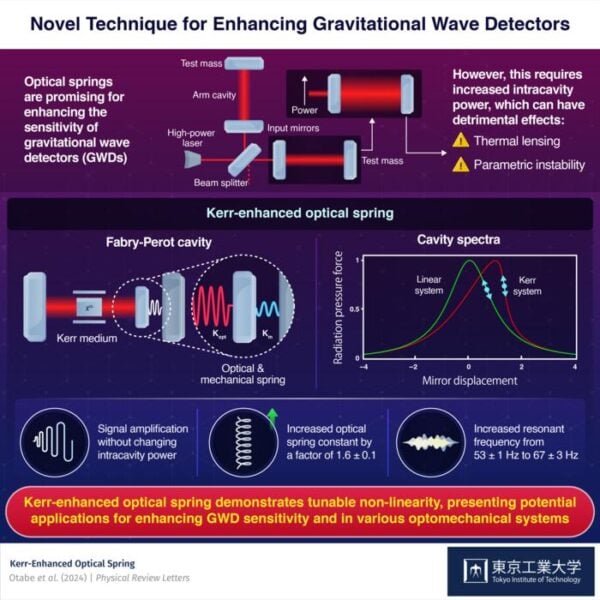Gravitational waves, ripples in the fabric of space-time, have been a hot topic in the world of physics since their first detection in 2017. These waves, caused by the merger of two neutron stars, have provided scientists with invaluable information about the universe, from the origin of short gamma-ray bursts to the formation of heavy elements.
However, detecting gravitational waves from post-merger remnants has been a challenge due to their frequency range lying outside the range of modern gravitational wave detectors (GWDs).
To overcome this hurdle, a team of Japanese researchers, led by Associate Professor Kentaro Somiya and Dr. Sotatsu Otabe from the Department of Physics at Tokyo Tech, has developed a groundbreaking solution: the Kerr-enhanced optical spring. This innovative design aims to enhance the sensitivity of GWDs, allowing them to detect the elusive gravitational waves that hold crucial insights into the internal structure of neutron stars.
Optical springs are a key component in GWDs, using the radiation pressure force from light to mimic spring-like behavior. The stiffness of these springs is determined by the light power within the optical cavity. Traditionally, increasing the resonant frequency of optical springs required increasing the intracavity light power, which could lead to harmful thermal effects and prevent the detector from working properly.
The Kerr-enhanced optical spring, however, takes a different approach. By inserting a Kerr medium into a Fabry-Perot type optomechanical cavity, the researchers were able to generate an intracavity signal amplification effect. The Kerr medium induces an optical Kerr effect in the cavity, where an optical field changes the refractive index of the medium. This creates a significant gradient of the radiation pressure force in the cavity, enhancing the optical spring constant without increasing intracavity power.
“A promising method to enhance the impact of optical springs without increasing intracavity power is intracavity signal amplification. This technique enhances the signal amplification ratio of the cavity by using non-linear optical effects and enhances the optical spring constant. Our research revealed that the optical Kerr effect is a promising approach for successfully utilizing this technique,” explains Prof. Somiya.
Experiments conducted by the research team showed that the optical Kerr effect successfully enhanced the optical spring constant by a factor of 1.6, increasing the resonant frequency of the optical spring from 53 Hz to 67 Hz. The researchers believe that with further refinement of technical issues, an even larger signal amplification ratio can be achieved.
Dr. Otabe emphasizes the importance of this study, stating, “The proposed design is easy to implement and provides a novel tuneable parameter for optomechanical systems. We believe that demonstrated technique will play a key role not only in GWDs but also in other optomechanical systems, such as in cooling macroscopic oscillators to their quantum ground state.”
The Kerr-enhanced optical spring represents a significant step forward in the field of gravitational wave detection. By enabling GWDs to detect gravitational waves that were previously out of reach, this innovation has the potential to unlock new insights into the mysteries of our universe. Moreover, the technique’s applicability extends beyond GWDs, with the potential to impact other optomechanical systems as well.
As scientists continue to push the boundaries of what is possible in the realm of physics, discoveries like the Kerr-enhanced optical spring bring us closer to understanding the fundamental nature of the universe. With the development of next-generation GWDs and the implementation of cutting-edge technologies like the Kerr-enhanced optical spring, we are poised to unravel the secrets hidden within gravitational waves and gain a deeper understanding of the cosmos.


